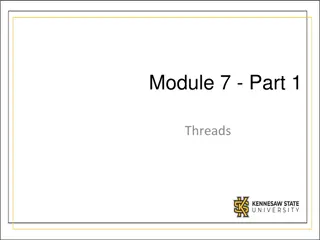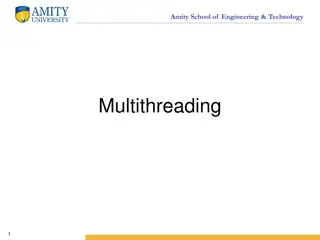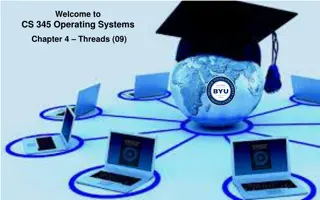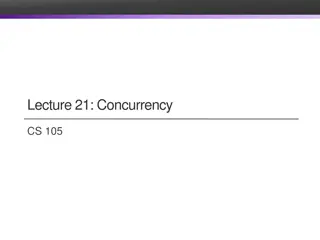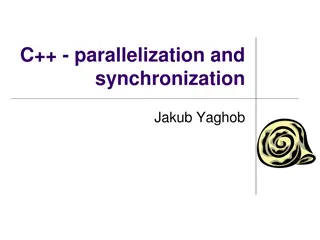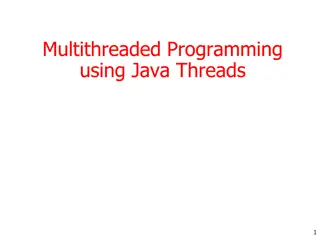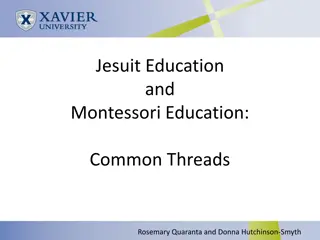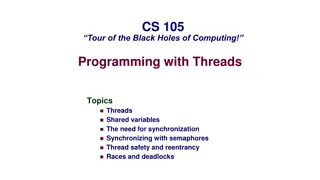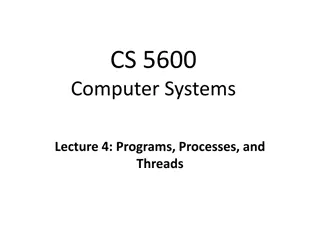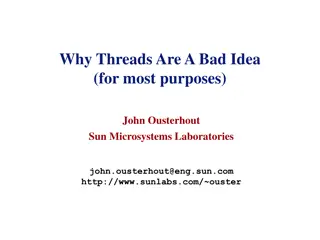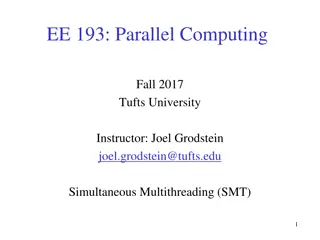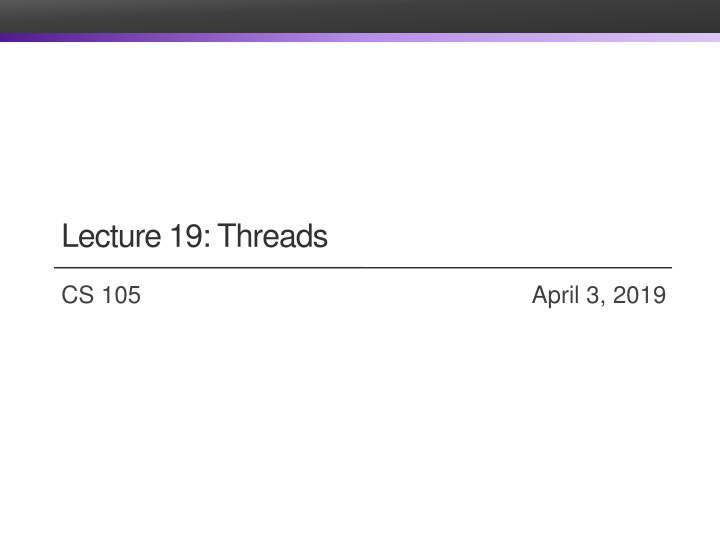
Threads and Processes in Computer Science
Explore the fundamental concepts of threads and processes in computer science, including their definitions, key abstractions, traditional and alternate views of processes, and the differences between threads and processes.
Download Presentation

Please find below an Image/Link to download the presentation.
The content on the website is provided AS IS for your information and personal use only. It may not be sold, licensed, or shared on other websites without obtaining consent from the author. If you encounter any issues during the download, it is possible that the publisher has removed the file from their server.
You are allowed to download the files provided on this website for personal or commercial use, subject to the condition that they are used lawfully. All files are the property of their respective owners.
The content on the website is provided AS IS for your information and personal use only. It may not be sold, licensed, or shared on other websites without obtaining consent from the author.
E N D
Presentation Transcript
Lecture 19: Threads CS 105 April 3, 2019
Processes Definition: A program is a file containing code + data that describes a computation Definition: A process is an instance of a running program. One of the most profound ideas in computer science Not the same as program or processor Memory Process provides each program with two key abstractions: Private address space Each program seems to have exclusive use of main memory. Provided by kernel mechanism called virtual memory Logical control flow Each program seems to have exclusive use of the CPU Provided by kernel mechanism called context switching Stack Heap Data Code CPU Registers
Traditional View of a Process Process = process context + code, data, and stack Process context Code, data, and stack Stack Program context: Data registers Condition codes Stack pointer (SP) Program counter (PC) Kernel context: VM structures Descriptor table brk pointer SP Shared libraries brk Run-time heap Read/write data Read-only code/data PC 0
Alternate View of a Process Process = thread + code, data, and kernel context Thread (main thread) Code, data, and kernel context Shared libraries Stack brk SP Run-time heap Read/write data Read-only code/data Thread context: Data registers Condition codes Stack pointer (SP) Program counter (PC) PC 0 Kernel context: VM structures Descriptor table brk pointer
A Process With Multiple Threads Multiple threads can be associated with a process Each thread has its own logical control flow Each thread has its own stack for local variables Each thread has its own thread id (TID) Each thread shares the same code, data, and kernel context Thread 1 (main thread) Thread 2 (peer thread) Shared code and data shared libraries stack 1 stack 2 run-time heap read/write data read-only code/data Thread 1 context: Data registers Condition codes SP1 PC1 Thread 2 context: Data registers Condition codes SP2 PC2 0 Kernel context: VM structures Descriptor table brk pointer
Threads vs. Processes How threads and processes are similar Each has its own logical control flow Each can run concurrently with others (possibly on different cores) Each is context switched
Concurrent Threads Two threads are concurrent if their flows overlap in time Otherwise, they are sequential Thread A Thread B Thread C Examples: Concurrent: A & B, A&C Sequential: B & C Time
Concurrent Thread Execution Single Core Processor Simulate parallelism by time slicing Multi-Core Processor Can have true parallelism Thread A Thread B Thread C Thread A Thread B Thread C Time Run 3 threads on 2 cores
Threads vs. Processes How threads and processes are similar Each has its own logical control flow Each can run concurrently with others (possibly on different cores) Each is context switched How threads and processes are different Threads share all code and data (except local stacks) Processes (typically) do not Threads are somewhat less expensive than processes Process control (creating and reaping) twice as expensive as thread control Linux numbers: ~20K cycles to create and reap a process ~10K cycles (or less) to create and reap a thread
Logical View of Threads Threads associated with process form a pool of peers Unlike processes which form a tree hierarchy Process hierarchy Threads associated with process foo P0 T2 T4 T1 P1 shared code, data and kernel context sh sh sh T3 T5 foo bar
Posix Threads (Pthreads) Interface Pthreads: Standard interface for ~60 functions that manipulate threads from C programs Creating and reaping threads pthread_create() pthread_join() Determining your thread ID pthread_self() Terminating threads pthread_cancel() pthread_exit() exit() [terminates all threads] , RET [terminates current thread]
The Pthreads "hello, world" Program /* * hello.c - Pthreads "hello, world" program */ #include "csapp.h" void *thread(void *vargp); Thread attributes (usually NULL) Thread ID int main() { pthread_t tid; Pthread_create(&tid, NULL, thread, NULL); Pthread_join(tid, NULL); exit(0); } Thread routine Thread arguments (void *p) hello.c Return value (void **p) void *thread(void *vargp) /* thread routine */ { printf("Hello, world!\n"); return NULL; } hello.c
Execution of Threaded hello, world Main thread call Pthread_create() Pthread_create() returns Peer thread call Pthread_join() printf() Main thread waits for peer thread to terminate return NULL; Peer thread terminates Pthread_join() returns exit() Terminates main thread and any peer threads
Using Threads for Parallelism on a multi-core system, the OS can schedule concurrent threads in parallel on multiple cores so concurrent programs can run faster that sequential programs 1.06 1.2 1 0.8 Elapsed time (s) 0.6 0.54 0.4 0.3 0.29 0.28 0.2 0 1 2 4 8 16 Threads
15 Shared Variables in Threaded Programs Question: Which variables in a threaded C program are shared? The answer is not as simple as global variables are shared and stack variables are private Def: A variable x is shared if and only if multiple threads refer to some instance of x. Requires answers to the following questions: What is the memory model for threads? How are instances of variables mapped to memory? How many threads might refer to each of these instances?
16 Threads Memory Model Conceptual model: Multiple threads run within the context of a single process Each thread has its own separate thread context Thread ID, stack, stack pointer, PC, condition codes, and GP registers All threads share the remaining process context Code, data, heap, and shared library segments of the process virtual address space Open files and installed handlers Operationally, this model is not strictly enforced: Register values are truly separate and protected, but Any thread can read and write the stack of any other thread The mismatch between the conceptual and operation model is a source of confusion and errors
17 Example Program to Illustrate Sharing void *thread(void *vargp) { long myid = (long)vargp; static int cnt = 0; char **ptr; /* global var */ int main() { long i; pthread_t tid; char *msgs[2] = { "Hello from foo", "Hello from bar" }; printf("[%ld]: %s (cnt=%d)\n", myid, ptr[myid], ++cnt); return NULL; } Peer threads reference main thread s stack indirectly through global ptr variable ptr = msgs; for (i = 0; i < 2; i++) Pthread_create(&tid, NULL, thread, (void *)i); Pthread_exit(NULL); } sharing.c
18 Mapping Variable Instances to Memory Global variables Def: Variable declared outside of a function Virtual memory contains exactly one instance of any global variable Local variables Def: Variable declared inside function without static attribute Each thread stack contains one instance of each local variable Local static variables Def: Variable declared inside function with the static attribute Virtual memory contains exactly one instance of any local static variable.
19 Mapping Variable Instances to Memory Global var: 1 instance (ptr [data]) Local vars: 1 instance (i.m, msgs.m) char **ptr; /* global var */ Local var: 2 instances ( myid.p0 [peer thread 0 s stack], myid.p1 [peer thread 1 s stack] ) int main() { long i; pthread_t tid; char *msgs[2] = { "Hello from foo", "Hello from bar" }; void *thread(void *vargp) { long myid = (long)vargp; static int cnt = 0; ptr = msgs; for (i = 0; i < 2; i++) Pthread_create(&tid, NULL, thread, (void *)i); Pthread_exit(NULL); printf("[%ld]: %s (cnt=%d)\n", myid, ptr[myid], ++cnt); return NULL; } Local static var: 1 instance (cnt [data]) } sharing.c
20 Shared Variable Analysis Which variables are shared? Variable Referenced by instance main thread? Referenced by peer thread 0? Referenced by peer thread 1? yes no yes yes no no yes yes no yes yes no yes yes no yes no yes ptr cnt i.m msgs.m myid.p0 myid.p1 Answer: A variable x is shared iff multiple threads reference at least one instance of x. Thus: ptr, cnt, and msgs are shared i and myid are not shared
Pros and Cons of Thread-Based Designs + Threads are more efficient than processes + Easy to share data structures between threads e.g., logging information, file cache - Unintentional sharing can introduce subtle and hard- to-reproduce errors! The ease with which data can be shared is both the greatest strength and the greatest weakness of threads Hard to know which data shared & which private Hard to detect by testing Probability of bad race outcome very low. But nonzero!
22 badcnt.c: Improper Synchronization /* Thread routine */ void *thread(void *vargp) { long i, niters = *((long *)vargp); for (i = 0; i < niters; i++) cnt++; /* Global shared variable */ volatile long cnt = 0; /* Counter */ int main(int argc, char **argv) { long niters; pthread_t tid1, tid2; niters = atoi(argv[1]); Pthread_create(&tid1, NULL, thread, &niters); Pthread_create(&tid2, NULL, thread, &niters); Pthread_join(tid1, NULL); Pthread_join(tid2, NULL); return NULL; } linux> ./badcnt 10000 OK cnt=20000 linux> ./badcnt 10000 BOOM! cnt=13051 linux> /* Check result */ if (cnt != (2 * niters)) printf("BOOM! cnt=%ld\n", cnt); else printf("OK cnt=%ld\n", cnt); exit(0); } cnt should equal 20,000. What went wrong? badcnt.c
23 Assembly Code for Counter Loop C code for counter loop in thread i for (i = 0; i < niters; i++) cnt++; Asm code for thread i movq (%rdi), %rcx testq %rcx,%rcx jle .L2 movl $0, %eax .L3: movq cnt(%rip),%rdx addq $1, %rdx movq %rdx, cnt(%rip) addq $1, %rax cmpq %rcx, %rax jne .L3 .L2: Hi: Head Li : Load cnt Ui : Update cnt Si : Store cnt Ti : Tail
Safe Schedules A schedule of instructions is safe if the resulting concurrent computation returns the correct answer Assume two threads executing routine thread. Which of the following schedules are safe? ?1,?1,?1,?1,?2,?2,?2,?2,?2,?1 ?2,?2,?1,?1,?1,?1,?1,?2,?2,?2 ?1,?2,?2,?2,?2,?1,?1,?1,?1,?2
25 Progress Graphs A progress graph depicts the discrete execution state space of concurrent threads. Thread 2 T2 (L1, S2) Each axis corresponds to the sequential order of instructions in a thread. S2 U2 Each point corresponds to a possible execution state (Inst1, Inst2). L2 E.g., (L1, S2) denotes state where thread 1 has completed L1 and thread 2 has completed S2. H2 Thread 1 H1 L1 U1 S1 T1
26 Trajectories in Progress Graphs Thread 2 A trajectory is a sequence of legal state transitions that describes one possible concurrent execution of the threads. T2 Example: S2 H1, L1, U1, H2, L2, S1, T1, U2, S2, T2 U2 L2 H2 Thread 1 H1 L1 U1 S1 T1
27 Critical Sections and Unsafe Regions Thread 2 L, U, and S form a critical section with respect to the shared variable cnt T2 Instructions in critical sections (wrt some shared variable) should not be interleaved S2 critical section wrt cnt U2 Unsafe region Sets of states where such interleaving occurs form unsafe regions L2 H2 Thread 1 H1 L1 U1 S1 T1 critical section wrt cnt
28 Critical Sections and Unsafe Regions Thread 2 safe Def: A trajectory is safe iff it does not enter any unsafe region T2 Claim: A trajectory is correct (wrt cnt) iff it is safe S2 critical section wrt cnt U2 Unsafe region unsafe L2 H2 Thread 1 H1 L1 U1 S1 T1 critical section wrt cnt
29 Enforcing Mutual Exclusion Question: How can we guarantee a safe trajectory? Answer: We must synchronizethe execution of the threads so that they can never have an unsafe trajectory. i.e., need to guarantee mutually exclusive access for each critical section. Possible solutions: Locks Semaphores Condition variables


